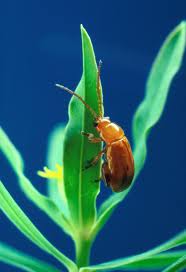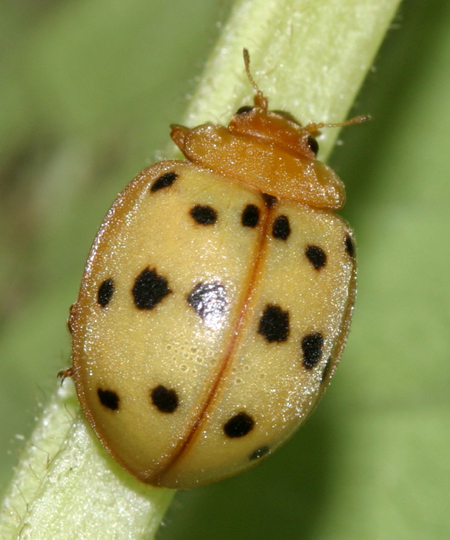Interactions

To
start off, humans are interacting greatly with watermelons.
Not only do we plant them, and selectively breed them, but we eat
them! After the flower produces the fruit, we open it up and eat the
sweet tasting flesh. You can learn all about how we use them for food
under food/facts.
Mutualists!
There are many organisms that are involved in a mutualistic
relationship with the Citrullus lanatus. Mutualistic
relationships are very positive, as other organisms benefit in
some way. Organisms considered mutualists with the watermelon
are also known as pollinators. There are a number of insects
involved in pollinating the watermelon, but the honeybee is the
most common.
The honeybee
As talked about on the reproduction page, the honey bee
plays a large part in pollinating the Citrullus lanatus,
as it is their primary pollinator. Like all bees, honeybees have
basket-like structures on their hind legs in order to store
pollen they collect from male flowers and use it as nutrition
for them. Pollen that remains on the bee outside the baskets
falls onto the female flowers when they land on them,
benefitting the plant by allowing it to reproduce.
Parasites!
Unfortunately, the watermelon serves as a host to a number of
parasites. A parasitic relationship involves one organism while the
other organism (in this case the watermelon) is harmed. Both fungi and
bacteria are very common organisms that create symbioses with plants. When they are parasitic, they are commonly known as a pathogens. A
popular fungus that causes disease to the Citrullus lanatus is
the Didymella bryoniae, also known as the gummy stem blight. In
addition, a common bacterial pathogen involves the disease, bacterial
fruit blotch.
 Gummy
Stem Blight
Gummy
Stem Blight
This organism does well in warm, wet weather, which happens to be the
exact same weather watermelons do well in. By living within the
watermelon, the gummy stem blight benefits by stealing nutrients and
having a safe place to live. By creating lesions on it, the watermelon
suffers with negative effects in growth and reproduction. The
Didymella bryoniae reproduces on crop residue. Physical symptoms of
this pathogen includes indefinite-shaped lesion on the leaf, stem, or
vine, lesions being chocolate brown, water-soaked stems, and the plant
tissue appearing woody.
Bacterial fruit blotch
The organism that creates this watermelon disease is the Acidovorax
avenae. This disease can cause the watermelon to completely stop
growing, or slow down its growth, depending on the stage in the
watermelon life it begins to infect. The bacteria benefits from the
nutrients. It can be seen on the seedling transplants and/or the mature
leaves and fruit. If the vines are infected, they do not drop their
leaves negatively effecting growth and photosynthesis resources. This
bacterium is identified as being small, dark, and angled.
Preadators!
The Citrullus lanatus is a victim of a number of
different predators. A predator is an organism that harms
another organism while benefiting itself. In many cases, the
predator kills the other organism. Some predators of the
watermelon include aphids, flea beetles, red spider mites,
root-knot nematodes, whiteflies, and Epilachna beetles.
 Aphids
Aphids
Aphids…one of plants most common predators. Aphids are small
herbivorous animals that feed via a structure called a stylet on
the sugars, directly from an individual sieve tube member within
the phloem cells, which is discussed on the
nutrition page. The cotton aphid (Aphis gossypii) is the
common aphid interacting with the watermelon. They are normally
found on the lower leaf surface. This predatory relationship
benefits the aphids while it provides them with direct
nutrients. They harm the watermelon directly by stunting shoots
and leaves, and transmitting virus diseases while they feed from
one plant to another. Indirectly, the aphids harm them by
leading on the growth of sooty mould from creating honeydew,
which attracts fruit flies, another harm to the fruit.
Flea Beetles
The flea beetles (Podagrica
spp.) are tiny 1.5-3 mm long beetles that feed on the roots
or the leaves of the watermelon. They have adapted
well-developed hind legs in order to quickly jump if disturbed.
As larvae, the flea beetles feed on the roots of the watermelon.
As adults these beetles chew and feed on the leaves, creating
holes; or they feed directly from the fruit. Often times, young
watermelon plants can’t handle the predation, and it leads them
to death. However, adult watermelon plants can normally handle
the stress, and live through it if it’s not an excessive amount.
 Red spider mites
Red spider mites
Red spider mites (Tetranychus
spp.) are tiny as well, being 0.6mm long and harm the
leaves of the watermelons. These predators are most harmful in
very dry and hot conditions. They cause young watermelon plants
to die, and the adult watermelon plant to have stunted growth
and a reduced fruit.

Root-knot nematodes
Root-knot nematodes (Meloidogyne
spp.) are a problem in multiple crops. They are animals
that wilt the plants, distorting the roots. The distorting of
the roots causes them to rot, and eventually kill the plant
entirely.
 Whiteflies
Whiteflies
Whiteflies (Bemisia
tabaci) are major transfers of disease. Much like aphids,
they carry diseases from one plant to another by sucking plant
sap and creating honeydew, and eventually the growth of moulds.
This affects the growth of plants as well, leading to damage.
Whiteflies attack many other cucurbits as well, such as the
cucumber.

Epilachna Beetles
Epilachna beetles (Epilachna
chrysomelina) are 6-8mm long. Both their larvae and adult
forms feed on the leaves of plants, including the watermelon.
This causes the leaves to shrivel and dry up, and/or kill the
plant entirely, especially young plants. These animals are also
known as the African melon ladybird.
Now that you are aware of who is involved with the Citrullus lanatus, click here to learn some very interesting facts!